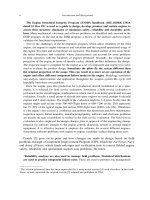Concise Dictionary of Materials Science Part 3 ppt
Bạn đang xem bản rút gọn của tài liệu. Xem và tải ngay bản đầy đủ của tài liệu tại đây (38.02 KB, 3 trang )
conjugate slip system
Slip system becoming active after the resolved shear
stress on a primary slip system decreases below critical value, due to a
lattice rotation in the course of plastic deformation. See Schmid’s law.
conode
See tie line.
constitution diagram
See phase diagram.
constitutional undercooling/supercooling
Undercooling of melt due to changes
in its equilibrium solidification temperature, T
0
, caused by changes in the
solute concentration next to the solid/liquid interface. If the actual melt
temperature is lower than T
0
, the melt is constitutionally undercooled, which
results in an instability of the planar shape of the interface. This instability
leads to the evolution of cellular or dendritic structures, depending on the
undercooling and the linear growth rate.
constraint
Restriction of a process, e.g., of the crystal growth or plastic defor-
mation.
continuous cooling transformation (CCT) diagram
Presentation of the evolu-
tion of phase transformations at different cooling rates by lines, in coor-
dinates temperature–time, corresponding to the transformation start and
its finish.
continuous grain growth
See normal grain growth.
continuous precipitation
Phase transformation evolving according to the
occurrence and diffusion-controlled growth of new phase precipitates
inside the parent phase.
continuous recrystallization
Process of microstructural alterations on anneal
-
ing plastically deformed material, which results in a decrease of the overall
dislocation density and the formation of strain-free subgrains. A further
annealing is accompanied by subgrain growth only, identical to normal
grain growth. This can be explained by the exhaustion of the elastic strain
energy associated with lattice defects, which might contribute to the for
-
mation of recrystallization nuclei. Continuous recrystallization is
observed in materials of high stacking-fault energy (e.g., in Al alloys),
where dislocation rearrangements, leading to the formation of subgrain
structure, evolve fast. Precipitation from supersaturated solid solution
enhances continuous recrystallization because it retards the evolution of
recrystallization nuclei. The latter is a result of the preferential arrange
-
ment of precipitates at subboundaries (see heterogeneous nucleation),
which inhibits their migration (see particle drag). Because of this, an
increase of the disorientation angle at the subboundaries, their transfor
-
mation into high-angle boundaries, and the formation of the recrystalli-
zation nuclei are inhibited. Continuous recrystallization is also called
recrystallization inþsitu.
continuous [x-ray] spectrum
See white radiation.
controlled rolling
Thermo-mechanical treatment of low-alloy steels with <0.1
wt% C, aiming at increasing their toughness and strength by decreasing
ferrite grain size (see grain-boundary strengthening), as well as by
increasing the volume fraction of dispersed phases (see precipitation
strengthening). The main stage of controlled rolling is hot deformation,
© 2003 by CRC Press LLC
conjugate slip system
Slip system becoming active after the resolved shear
stress on a primary slip system decreases below critical value, due to a
lattice rotation in the course of plastic deformation. See Schmid’s law.
conode
See tie line.
constitution diagram
See phase diagram.
constitutional undercooling/supercooling
Undercooling of melt due to changes
in its equilibrium solidification temperature, T
0
, caused by changes in the
solute concentration next to the solid/liquid interface. If the actual melt
temperature is lower than T
0
, the melt is constitutionally undercooled, which
results in an instability of the planar shape of the interface. This instability
leads to the evolution of cellular or dendritic structures, depending on the
undercooling and the linear growth rate.
constraint
Restriction of a process, e.g., of the crystal growth or plastic defor-
mation.
continuous cooling transformation (CCT) diagram
Presentation of the evolu-
tion of phase transformations at different cooling rates by lines, in coor-
dinates temperature–time, corresponding to the transformation start and
its finish.
continuous grain growth
See normal grain growth.
continuous precipitation
Phase transformation evolving according to the
occurrence and diffusion-controlled growth of new phase precipitates
inside the parent phase.
continuous recrystallization
Process of microstructural alterations on anneal
-
ing plastically deformed material, which results in a decrease of the overall
dislocation density and the formation of strain-free subgrains. A further
annealing is accompanied by subgrain growth only, identical to normal
grain growth. This can be explained by the exhaustion of the elastic strain
energy associated with lattice defects, which might contribute to the for
-
mation of recrystallization nuclei. Continuous recrystallization is
observed in materials of high stacking-fault energy (e.g., in Al alloys),
where dislocation rearrangements, leading to the formation of subgrain
structure, evolve fast. Precipitation from supersaturated solid solution
enhances continuous recrystallization because it retards the evolution of
recrystallization nuclei. The latter is a result of the preferential arrange
-
ment of precipitates at subboundaries (see heterogeneous nucleation),
which inhibits their migration (see particle drag). Because of this, an
increase of the disorientation angle at the subboundaries, their transfor
-
mation into high-angle boundaries, and the formation of the recrystalli-
zation nuclei are inhibited. Continuous recrystallization is also called
recrystallization inþsitu.
continuous [x-ray] spectrum
See white radiation.
controlled rolling
Thermo-mechanical treatment of low-alloy steels with <0.1
wt% C, aiming at increasing their toughness and strength by decreasing
ferrite grain size (see grain-boundary strengthening), as well as by
increasing the volume fraction of dispersed phases (see precipitation
strengthening). The main stage of controlled rolling is hot deformation,
© 2003 by CRC Press LLC
D
δ-Fe
Allotropic form of iron having BCC crystal structure and existing at atmo
-
spheric pressure at temperatures above A
4
(i.e., > 1400°C) up to the melting
point.
δ-ferrite
Solid solution of alloying elements and/or carbon in δ-Fe.
∆r-value
Quantity characterizing planar anisotropy in sheets:
∆
r = (r
0
+ r
90
– 2r
45
)/4
where r is the r-value, and the subscripts 0, 45, and 90 denote the angles
between the axis of the tension specimen and RD of the sheet.
dark-field illumination
In optical microscopes, such illumination that flat hor-
izontal features of an opaque sample appear dark, whereas all the inclined
features appear bright (e.g., in single-phase materials, grains are dark and
grain boundaries bright, in contrast to bright-field illumination). This is
due to the fact that the inclined features reflect the incident light into an
objective, whereas the horizontal features do not.
dark-field image
High-resolution image produced by a diffracted beam directed
along the TEM axis. The contrast in a dark-field image is opposite to that
in a bright-field one, e.g., a dislocation line is bright in the former and
dark in the latter.
Debye–Scherrer method
Powder method wherein a needle-like polycrystalline
specimen is placed along the axis of a cylindrical camera and a film is
placed inside the camera on its wall. A monochromatic and collimated
primary x-ray beam is directed onto the specimen along the camera
diameter. The specimen can be rotated during the exposition.
decomposition
In a phase diagram with a miscibility gap, a phase transition in
a solid solution, α, which decomposes upon cooling into isomorphous
solid solutions, α
1 a
nd α
2 (
see Figure D.1). The same term is used to
designate certain phase transformations in the solid state, e.g., eutectoid
decomposition, decomposition of supersaturated solid solution on aging
treatment into precipitates and saturated solid solution, decomposition of
cementite on graphitization into austenite and graphite, etc. In the two
latter cases, decomposition is connected with the transformation of a
metastable phase into more stable ones.
© 2003 by CRC Press LLC









